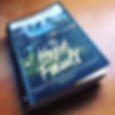
Tracy Farr is an Australian who has lived in New Zealand for the last 20 or so years. The Hope Fault is her second novel, and it’s a gorgeous piece of work. It is ostensibly about a family who return mid-winter to pack up the family holiday house together, and in doing so the warp and the weft of their relationships is gradually uncovered, but the real heart of this book lies in its theme of storytelling.
At the beginning of the book there appears a quote from Tolkien’s ‘On Fairy-Stories’:
“It was in fairy-stories that I first divined the potency of the words, and the wonder of the things, such as stone, and wood, and iron; tree and grass; house and fire; bread and wine.”
Tracy has written an intelligent novel which demonstrates some of the different guises in which a story may be delivered - fairy tale, graphic art, embroidery, landscape, baking, poetry, letter-writing, diary-keeping. There is no one way or right way to tell a story, and we are all complicit in the creation of them - what we leave in, what we leave out. What we elect to share, what we cover over, embellish or even delete. Who we tell, or show.
There are family secrets, of course there are, and they are revealed slowly, layer by layer. The generations are unpicked, and merged. Time collapses, and stretches. The children at times seem aged. The elderly and middle-aged become young again, through memory and retelling. The house becomes a home for a while to new technologies and old.
Running through the book, like a fault line, is a disturbing tilt which builds in the reader an anxiety. There are ominous signs to set the reader on edge. Threatening clouds. A lost phone. A trip to the hospital. A drive with a wrong turn. A teen with the black dog on his heels. An ex-wife/new wife. A drunken party. A found book. A black shape in the water. An unnamed baby. Tracy defuses some situations, sets off others. Answers aren't always provided. Such is life.
While Tracy may be a scientist, she has the heart of a poet. I adored this book. It had echoes of Virginia Woolf, where describing a plot is almost impossible – there is altogether so much more going on, and a lot of it beneath the surface like a dark shape in the water.
(Tracy visited Blarney Books & Art in July as part of the Bad Diaries events, with Jenny Ackland, Emma Viskic and Rochelle Siemienowicz.)